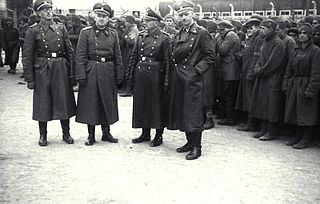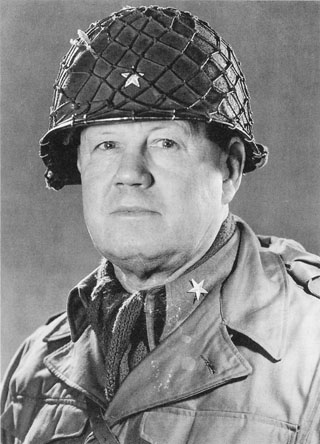
Dachau was one of the first concentration camps built by Nazi Germany and the longest running one, opening on 22 March 1933. The camp was initially intended to intern Hitler's political opponents, which consisted of communists, social democrats, and other dissidents. It is located on the grounds of an abandoned munitions factory northeast of the medieval town of Dachau, about 16 km (10 mi) northwest of Munich in the state of Bavaria, in southern Germany. After its opening by Heinrich Himmler, its purpose was enlarged to include forced labor, and eventually, the imprisonment of Jews, Romani, German and Austrian criminals, and, finally, foreign nationals from countries that Germany occupied or invaded. The Dachau camp system grew to include nearly 100 sub-camps, which were mostly work camps or Arbeitskommandos, and were located throughout southern Germany and Austria. The main camp was liberated by U.S. forces on 29 April 1945.

The 20th Armored Division was an armored division of the United States Army that fought in World War II. It was activated on 15 March 1943 at Camp Campbell in Kentucky.

The 45th Infantry Division was an infantry division of the United States Army, most associated with the Oklahoma Army National Guard, from 1920 to 1968. Headquartered for most of its history in Oklahoma City, Oklahoma, the guardsmen fought in both World War II and the Korean War.

The Gardelegen massacre was a massacre perpetrated by the locals of the northern German town of Gardelegen, with direction from the SS, near the end of World War II. On April 13, 1945, on the Isenschnibbe estate near the town, the troops forced over 1,000 slave laborers who were part of a transport train evacuated from the Mittelbau-Dora and Hannover-Stöcken concentration camps into a large barn, which was then set on fire.

SS-Totenkopfverbände was the Schutzstaffel (SS) organization responsible for administering the Nazi concentration camps and extermination camps for Nazi Germany, among similar duties. While the Totenkopf was the universal cap badge of the SS, the SS-TV also wore this insignia on the right collar tab to distinguish itself from other SS formations.
During World War II, the Allies committed legally proven war crimes and violations of the laws of war against either civilians or military personnel of the Axis powers. At the end of World War II, many trials of Axis war criminals took place, most famously the Nuremberg Trials and Tokyo Trials. In Europe, these tribunals were set up under the authority of the London Charter, which only considered allegations of war crimes committed by people who acted in the interests of the Axis powers. Some war crimes involving Allied personnel were investigated by the Allied powers and led in some instances to courts-martial. Some incidents alleged by historians to have been crimes under the law of war in operation at the time were, for a variety of reasons, not investigated by the Allied powers during the war, or were investigated but not prosecuted.

Felix Laurence Sparks was an American attorney, government official, and military officer from Colorado. A veteran of World War II, he attained the rank of brigadier general in the Colorado Army National Guard and received the Silver Star and the Purple Heart. Sparks also served as District Attorney of Colorado's 7th Judicial District, an Associate Justice of the Colorado Supreme Court, and the longtime director of the Colorado Water Conservation Board.

Kaufering was a system of eleven subcamps of the Dachau concentration camp which operated between 18 June 1944 and 27 April 1945 and which were located around the towns of Landsberg am Lech and Kaufering in Bavaria.

Munich-Allach concentration camp was a forced labour camp established by the Nazi Schutzstaffel (SS) in Allach-Untermenzing, a suburb of Munich in southern Germany, in 1943. It provided slave labour for nearby factories of BMW, Dyckerhoff, Sager & Woerner, Kirsch Sägemühle, Pumpel Lochhausen and Organisation Todt with up to 17,000 prisoners in 1945. More than 1,800 of them came to death. It was the largest sub-camp of the Dachau concentration camp system. Another smaller subcamp Allach porcelain a.k.a. Porzellan Manufaktur Allach with about 40 prisoners produced porcelain artworks.

Otto Förschner was a German Schutzstaffel (SS) officer and a Nazi concentration camp commander. After serving with the Waffen-SS on the Eastern Front, Förschner worked as a senior official at the Buchenwald concentration camp (1942-1943) and later served as the commandant of Mittelbau-Dora (1943-1945) and Kaufering (1945). Following the German defeat, he was convicted of war crimes by US occupation authorities at the Dachau trials and was hanged in May 1946.

During the Holocaust, death marches were massive forced transfers of prisoners from one Nazi camp to other locations, which involved walking long distances resulting in numerous deaths of weakened people. Most death marches took place toward the end of World War II, mostly after the summer/autumn of 1944. Hundreds of thousands of prisoners, mostly Jews, from Nazi camps near the Eastern Front were moved to camps inside Germany away from the Allied forces. Their purpose was to continue the use of prisoners' slave labour, to remove evidence of crimes against humanity, and to keep the prisoners from bargaining with the Allies.

The Dora Trial, also the "Dora"-Nordhausen or Dachau Dora Proceeding was a war crimes trial conducted by the United States Army in the aftermath of the collapse of the Third Reich. It took place between August 7 and December 30, 1947, on the site of the former Dachau concentration camp, Germany.

Brigadier General Henning Linden was a United States Army officer who served in World War II. He was notable for his role in the liberation of the Dachau concentration camp while serving as assistant division commander (ADC) of the 42nd Infantry Division.

The Buchenwald trial or United States of America vs. Josias Prince of Waldeck et al. was a war crime trial conducted by the United States Army as a court-martial in Dachau, then part of the American occupation zone. It took place from April 11 to August 14, 1947 in the internment camp of Dachau, where the former Dachau concentration camp had been located until late April 1945. In this trial, 31 people were indicted for war crimes related to the Buchenwald concentration camp and its satellite camps, all of whom were convicted. The Buchenwald trial was part of the Dachau trials, which were held between 1945 and 1948.

Boelcke-Kaserne concentration camp was a subcamp of the Mittelbau-Dora concentration camp complex where prisoners were left to die after they became unable to work. It was located inside a former Luftwaffe barracks complex in Nordhausen, Thuringia, Germany, adjacent to several pre-existing forced labor camps. During its three-month existence, about 6,000 prisoners passed through the camp and almost 3,000 died there under "indescribable" conditions. More than a thousand prisoners were killed during the bombing of Nordhausen by the Royal Air Force on 3–4 April 1945. Their corpses were found by the US Army units that liberated the camp on 11 April. Photographs and newsreel footage of the camp were reported internationally and made Nordhausen notorious in many parts of the world.

Franz Böttger was a German SS-Oberscharführer, employed as a supervising officer in the Dachau concentration camp. Following the war, he was tracked down and captured by surviving inmates from the camp. Böttger was convicted of war crimes and sentenced to death. He was executed in 1946. Former prisoners of Dachau had called Böttger "an outstanding example of inhuman cruelty and brutality."

The Dachau camp trial was the first mass trial of the Dachau trials, a series of trials against war criminals held by the United States Army on the premises of the Dachau concentration camp. The main trial took place from 15 November to 13 December 1945. Forty people were charged with war crimes in connection with the Dachau concentration camp and its subcamps. The trial ended with 40 convictions, including 36 death sentences, of which 28 were carried out. The official name of the case was United States of America vs. Martin Gottfried Weiss et al. - Case 000-50-2. The main trial served as a "parent case" for 123 subsequent cases. In the subsequent trials, all crimes that were established in the main trial were taken as proven, significantly shortening their duration relative to the parent case. The Dachau trials consisted of 6 total parent trials, each with their own subcases, and were held between 1945 and 1948. In total, there were 489 Dachau trials, of which 394 were held within the confines of the camp itself.

Dachau is a 72-page investigation report by the 7th US Army on Dachau, one of the concentration camps established by Nazi Germany. The report details the mass murder and mass atrocities committed at Dachau by the SS and other personnel. Following the liberation of the camp by the 7th US Army on 29 April 1945, the report was prepared during the following one or two weeks and published in May. In addition to a preface, the report contains three independent reports which partly overlap thematically. Although it contains some errors, the report is considered one of the first studies on the Nazi concentration camps.

Heinrich Wicker was a German SS-Untersturmführer. He was the last commandant of the Dachau concentration camp. In the final days of the war, Wicker was responsible for leading a death march in which nearly 200 prisoners died. He was later summarily executed by American soldiers during the Dachau liberation reprisals.

The Dachau Uprising was a revolt of Jewish prisoners in 1945 against Schutzstaffel (SS) guards in Dachau concentration camp during World War II. It happened during the Freiheitsaktion Bayern uprising against the Nazi regime.























